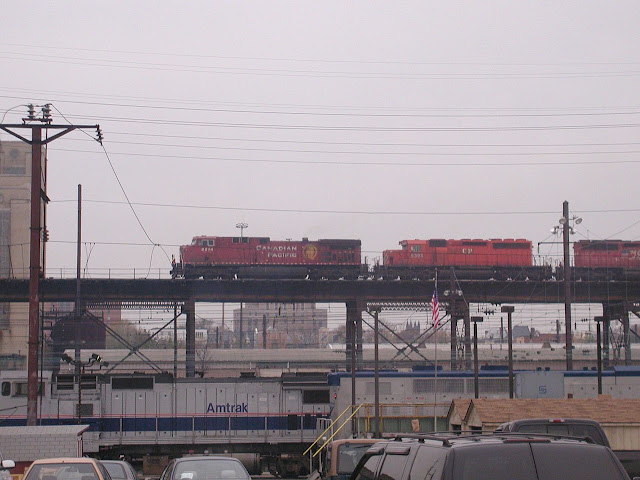Back in 2005 I was still somewhat active with my old scout troop in South Jersey and every June the troop would take a rafting/canoe/bike trip on either the upper Lehigh or Delaware rivers. In 2005 the trip was of the bicycle variety down the Lehigh gourge from White Haven to Mach Chunk, a distance of about 15-20 miles. Using the former Central Railroad of New Jersey right of way, the trip, on a constant downgrade, would only take about 2-3 hours with a stop for lunch. After spending the night in Hope Creek State Park, the group would break early in the morning giving my dad and myself a few hours to check out the local railroad scene.
At that time the Reading and Northern was just starting to ramp up it's scenic passenger operations with a tourist train heading up the Lehigh Gourge between Mach Chunk and M&H Jct. In fact the R&N had restored a connection over the Lehigh river to connect to the former Conrail Lehigh Line. In later years the R&N would lease the Lehigh Line all the way up to Scranton and run all sorts of excursions between the tourist base on the Lehigh and the company HQ in Port Clinton. Having nothing better to do my dad and I went for a ride and I was able to get some photos from the open window coaches.
Also included in
this set are photos from the last day of operation of NORTH PHILADELPHIA interlocking tower located in...North Philadelphia.
In fact that is where I am going to start. NORTH PHILADELPHIA tower was built on the Phildelphia Connecting Railroad around 1915 at the junction of the Chestnut Hill West branch and the Main Line. It was probably built in conjunction with the CHW electrification project in mind and also managed trains stopping at the new station with it's novel high level platforms. At the time North Philadelphia was the primary station for the PRR's premier east-west long distance train in the Philadelphia region as running into downtown and having to reverse or wye was unacceptable. Therefore the trains would stop at North Philadelphia instead, with passengers connecting to local PRR trains or the Broad Street Subway. The tower had a 47 lever US&S Electro-Pneumatic interlocking machine and controlled ladders on either side of the station along with the previously mentioned junction. At some point in the 90's a mural was applied as a beautification project.


Here we see two things that aren't around anymore, NORTH PHILADELPHIA tower and Amtrak AEM-7 #944. I can remember when passing by the tower after dark on Amtrak NEC trains I could often see the model board lit up inside.
Here we see an arriving SEPTA R8 train with Silverliner IV #163. The signal to the right is 50L, protecting a trailing point crossover on the CHW branch and controlled from a separate table style interlocking machine next to the main frame. It is notable for being mounted on an very rare "basket" style mast that provided a signal-level working platform for signal maintainers. This signal became an automatic after the tower's closure, eventually being removed by SEPTA after a re-signaling effort about 10 years later.

The same SEPTA train making a stop at the generally disused North Philadelphia R8 station platform. Access to the far track is still via an underpass. Today the underpass has been closed and replaced by a pedestrian grade crossing. The 34R signal on the signal bridge is displaying Slow Approach for the diverging movement onto the NEC. The signal has already been replaced by a new LED colourized model, but is still worked by the tower. After the cut-over this same movement would be given a Medium Clear signal indication.

Here we see NORTH PHILADELPHIA tower standing next to the famous massive signal bridge that spanned both the Main Line and Chestnut Hill West branch. About 5 years prior to this, the east end of the interlocking had been spun off into it's own remote controlled plant called CLEARFIELD. After the tower closed the remainder of the interlocking would be re-named LEHIGH. Both projects involved substantial plant rationalization as many industrial and station tracks were no longer needed.
Skipping ahead to the Lehigh gourge, we find R&N SD50 #5033 providing power on the north side of the 3 car consist. A second SD50 was on the rear to avoid shoving. The R&N was and is all about preservation, even 2nd and 3rd generation diesel power like SD50's and GP30's. In 2005 the SD50's were both enjoying a fresh coat of paint that 10+ years later is looking rather worn out.
Although not currently operating, former Reading railroad T-1 class steam location #2102 was on hand for the tourists to look at. The engine had last operated in the 90's for both excursions and to pull the occasional freight train.
CNJ painted F3A's #56 and #57 were not unknown to me because at the time they had recently lived at Winslow Junction along with a matching F3B unit. Over the years they would occasionally return to Winslow before finally being sold and repainted at Steamtown.


















































